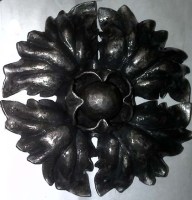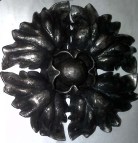Late Friday afternoon 9th August 2013 and the sun is still shining.
Today was the last ‘hand’ painting day (final coat is hand painted with a brush) and Lee the painter has gone off on holiday. The site is clear of scaffold and the enclosure covering, all the major work is complete on the ‘Tijou’ gates.
There are still a few little snags to sort out and the overthrow to be lifted into position, but that’s it. All the new and repaired work fitting went without a hitch and it is very difficult to tell the new work from the originals the discrete ID stamps are the only clue. The replicas (reproductions) are accurate and of similar character, without any embellishment or improvement in design or their manufacture. The repair work is the same, this is the result we aim for; it is so important in conservation and restoration to have minimum impact, not only on the physical structure but also the aesthetic appearance.
Asides, we can all improve upon our work, today, tomorrow, certainly years down the line and sometimes without check. I was advised as an apprentice that “a true craftsman’s most severe critic should be himself (herself)”. An Artisan, in the interests of economics, has to know when to call it a day and stop making. On occasion I reflect on work I’ve made and feel there are elements I’d perhaps change, omit, improve or do differently, but out of time and context any alterations or improvement would count for and achieve nothing. In the case of other peoples work, everyone can be a critic and some are quick to suggest ‘improvement’. The latter will always be subjective and inevitably very rude! So with this in mind if you are in a situation where you could physically alter or ‘improve’ (in your opinion) another craftsman’s work, to do so would be rude and I believe, unprofessional.
From a conservation perspective, there is an issue of historical accountability regards to reproduction and repair, however from a craftsman standpoint, to change or improve an existing, tangible design(s) is plain wrong. It works both ways too, you need to work to the exact standard that the original craftsman worked to, not less to make the job potentially easier and not more to satisfy your ego. You may have a reason to offer subjective comment in your report, but not to mess with the physical artifact you are being paid to replicate or repair.







